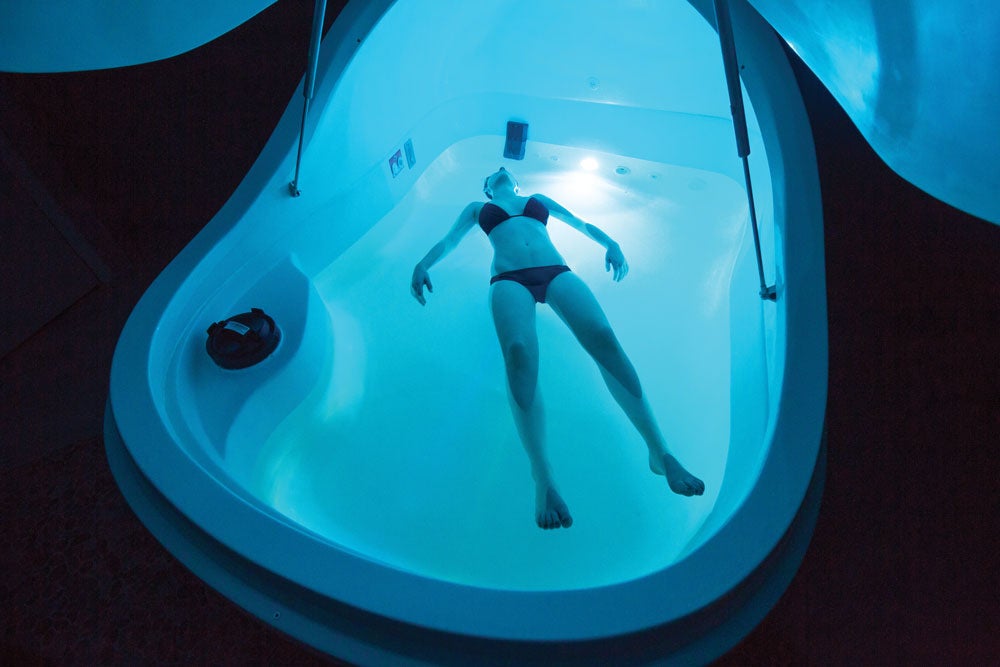Can Flotation Therapy Boost Performance?

Photo: True Rest Float Spa
Some people say flotation therapy boosts performance, but is it just a waste of money?
Float tanks, sensory deprivation tanks, isolation tanks—call them what you will, they’re everywhere. More than 400 locations now dot North America, and attendance at Portland’s Float Conference (yes, it’s a thing, held annually since 2012) nearly doubled from 2015 to 2016. Devotees say the tanks help relieve pain, reduce stress and can even improve your athletic performance. Should you take the plunge?
Here’s how it works: You get in a water-filled tank that’s pitch black and soundproof. The water is skin temperature and loaded with Epsom salt, so you float (saltwater is denser than fresh water, so you become more buoyant). This cuts off your senses. Without the ability to see, feel or hear anything on the outside, most people tend to go inward—users report an elevated sense of introspection and feeling like they’re out of their body, almost like a deep state of meditation or even a psychedelic experience.
The “far out”-sounding practice was created in 1954 by John C. Lilly, an eccentric but brilliant physician and human consciousness researcher who ran with the likes of poet and activist Allen Ginsberg and psychologist Timothy Leary, and in an experiment once took LSD and tried to communicate with dolphins. Separating a human from their senses, Lilly believed, may allow them to gain insight into their consciousness.
Sixty years later, athletes like NFL quarterback Tom Brady and NBA MVP Stephen Curry have taken to Lilly’s experiment, floating regularly, saying it improves their game. Peter Suedfeld, Ph.D., a professor and researcher at the University of British Columbia, says many other athletes report reaping benefits from floating. What gives?
“Flotation tanks are great for recovery,” says Greg Spatz, a DPT at Resilient Performance Physical Therapy in New York City. After a race or hard training session, your body begins to repair and build upon itself, which is what leads to improvement.
“Completely dropping environmental stressors lets your system relax and go into recovery mode,” Spatz says. “Faster, more thorough recovery allows you to continue to train harder, for longer periods of time, over the course of years so you can develop longevity in a grueling sport like triathlon.”
Science confirms Spatz’s claims: Scientists at Northern Illinois University had two groups of people do the same workout. Afterward, one group floated while the other just sat. The float group registered less blood lactate, indicating quicker recovery.
That hour or so without stimulation may also help people reduce life stress, says Suedfeld. Reduced stress is associated with a decreased risk of injury—athletes who were under higher life stress were nearly twice as likely to injure themselves, according to scientists at the University of Missouri.
One drawback could be if you’re devoting time to floating that could be spent working on lower hanging fruit, says Spatz. “For example, building more strength, or improving your movement quality or efficiency might have a greater payoff,” Spatz says. And because you can’t replicate floating at home—just try to completely noise-proof and black out your bathroom—you’ll pay anywhere from $30 to $80 a session.
But assuming your training is dialed in and you have the cash, floating once a week or after especially hard races may help you get faster in the long run, says Spatz. Just don’t float before competing. “It won’t be very helpful,” says Suedfeld. That’s because you don’t want to be too chilled out at the starting line—a bit of edginess can help you go harder.